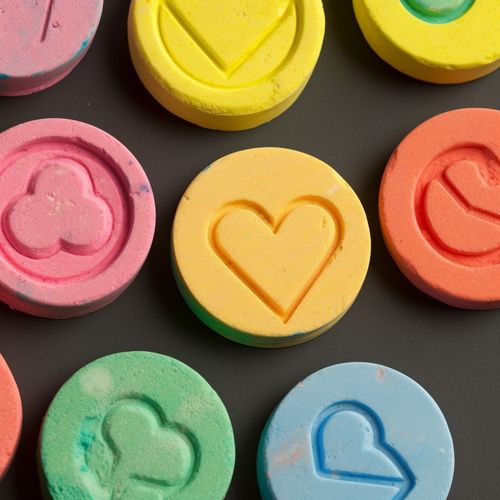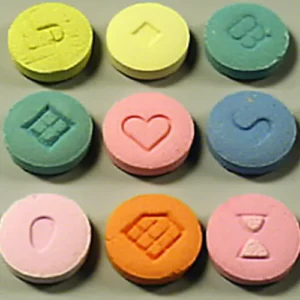Developed in 1912 by a pharmaceutical company known as Merck, ecstasy was first known as MDMA (an acronym based on its chemical structure). Over the next 40 years, the drug continued to be tested for a variety of purposes and in 1953 the United States Army began testing the drug for psychological warfare purposes. By the 1960s it was given by psychiatrists as a medication to help lower inhibitions.
It didn’t become known as a party drug until the next decade, in the mid-1970s. MDMA was widely spread under the brand name Ecstasy all the way up until 1984; after issues surrounding the drug’s health risks, however, it was banned in 1985.
Since then the term ecstasy continued to be used for similar drugs, most often by drug dealers as a marketing ploy, and often had little (or no) MDMA. In its purest form, like what was developed in the early 1900s, MDMA does have the ability to produce harmful side effects, the problem with the drug today is that it is often laced with other drugs including cocaine, methamphetamines, LSD, and heroin as well as non-drug substances like rat poison, dog deworming compounds, and other poisonous chemicals.
Because of these additional compounds found in the pills, ecstasy use is particularly dangerous especially because dealers prey on individuals who don’t care to check what they are taking. What a user takes from one batch to the next could be completely different. One time a user may get the high they are looking for and the next they could be taking a handful of rat poison and end up in a hospital or morgue.
What Does Ecstasy Look Like?
On the street ecstasy is usually found in its pill form. While they can appear white, most of the time they are vibrant colours with small logos and designed branded onto the side of the pill. Every once in a while ecstasy will be manufactured as a coloured or clear capsule and, on very rare occasions, it can be found as a loose white powder.
How Do Users Take Ecstasy?
In its most common tablet or capsule form, ecstasy is swallowed. There are occasions, though, that users will smoke or snort ecstasy powder or broken tablets. There is a substance that is known as liquid ecstasy often found on the market but it’s important to note that it is actually a depressant that affects the nervous system known as GHB (which is also found in degreasers and drain decloggers).
What Are The Short-Term Effects Of Ecstasy?
When a user first takes ecstasy the first thing they experience is often an energetic rush that typically starts about 30 minutes after a tablet or capsule has been swallowed. Once the effects start to take place, the user will feel a massive amount of energy, alertness, and a boost in confidence making it a popular choice for clubs because users can dance for hours at a time. The effects usually last 2 to 4 hours but can last as long as 6 depending on the user and the amount of drugs taken.
Negative effects of taking ecstasy include anxiety attacks, paranoia, depression, and panic attacks as well as physical symptoms like sickness and body stiffness.
It’s extremely important to note that there is often a delayed reaction to ecstasy; a high number of overdoses are a result of a user taking additional ecstasy tablets thinking the first didn’t work.
When you take ecstasy, one of the first short-term symptoms is a sudden and sharp rise in body temperature; additionally, taking ecstasy in a room filled with hundreds of other people (like a club) can cause your body temperature to rise even further, which commonly leads to heatstroke. This will result in the inability to sweat, sudden headaches, dizziness, nausea, and possibly unconsciousness.
It is strongly advised for any person who takes ecstasy to sip at up to, but no more than, one pint of water for every hour of dancing that they take part in, rinse their face with water (to help cool their body), and not drink alcoholic beverages (which can quicken the effects of dehydration).
In addition to a rise in body temperature, ecstasy also causes an elevated heart rate and increased blood pressure which can lead to heart attacks, strokes, and other problems for anyone who suffers from high blood pressure, heart disease, or diabetes.
Of all users who take ecstasy, females are more prone to death from taking the drug than males due to a higher level of oestrogen. When ecstasy is taken, a chemical imbalance occurs that causes water to be retained in the body; oestrogen prevents this excess water from being removed from the body which can dilute the body’s natural salt levels. As more water is retained and the salt levels within the body begin to diminish, central nervous system failure can occur which can result in death.
To prevent death or serious injury it is simply safest to avoid taking ecstasy in any form.
The Dangers Of Polydrug Use With Ecstasy
Many ecstasy users don’t realise they’re playing a dangerous game of chemical roulette. It’s not just about MDMA anymore – today’s pills often contain a cocktail of substances. You might think you’re just popping an innocent-looking tablet, but you could be ingesting a mix of stimulants, hallucinogens, and who knows what else.
Let’s break it down:
- Mixing ecstasy with alcohol? You’re cranking up the dehydration factor and putting extra strain on your liver.
- Throw some cocaine into the mix? Now we’re talking serious heart risks.
- Fancy a bit of ketamine with your E? Welcome to the dissociative danger zone.
The unpredictability is off the charts. One minute you’re riding the euphoric wave, the next you could be dealing with a potentially lethal drug interaction. It’s like playing chemical Russian roulette with your brain and body.
Remember, your friendly neighbourhood dealer isn’t exactly a pharmacist. They’re not weighing up drug interactions – they’re weighing up profits. So before you decide to “enhance” your roll, think twice. Your life might depend on it.
What Are The Long-Term Effects Of Ecstasy?
For users who take ecstasy on a regular, long-term basis have the risk of developing a psychological dependency on the drug. This can result in depression, lethargy, and insomnia. Additionally, the more times a user takes ecstasy, the higher their level of tolerance becomes—over time it will become increasingly difficult to achieve a high from a small amount of pills so users take more and more, raising the chance of serious side effects like paranoia, psychosis, or even death in addition to damaging the kidneys and liver.
Within the last 7 years, over 200 deaths have been caused by ecstasy in the United Kingdom alone.
How Long Does Ecstasy Remain In Your System?
Someone who has ecstasy in their system might be worried if they are subjected to random drug screening at work or if the court orders them to take a drug test. Remember, even if ecstasy cannot be detected via one kind of drug testing, like saliva testing, it could still be detected via hair or urine testing.
When testing for ecstasy or other kinds of drugs, urine testing is the most common test used since they are efficient, quick and non-invasive the person being tested. Following ingestion, ecstasy can be detected in the urine for around 2 -4 days. Most users have it totally out of their system in less than 3 days after ingestion. However, if the user has high alkalinity in their urine, the drug might be detectable for a longer period.
The user’s saliva can also be used to detect illegal drugs like ecstasy. For these tests, a certain amount of saliva is required to carry out the test. After ingestion, it could be detected as early as 1.5 hours and as high as 10 hours. Law enforcement officials use this kind of test on those who are arrested for driving while on drugs or other kinds of crimes related to drugs.
Once ecstasy has been ingested, it is detectable for up to 12 to 24 hours. After 24 hours, this kind of testing probably won’t detect any traces. Due to their invasive nature, these tests are not as common plus other kinds of testing are more available and simpler to administer.
When hair samples are used, ecstasy is detectable for as much as 90 days. Although ecstasy isn’t detectable right after ingestion when using a hair test, it stays in the system much longer compared to urine.
You might come across a few ways to get rid of the drug from the system quicker by getting the body to metabolise the drug faster, but the only guaranteed way for the drug not to show up is not to use it in the first place.
What Drug Classification Does Ecstasy Fall Within?
Ecstasy is considered a Class A drug making it illegal to produce the drug, supply it to others, or simply possess it.
Photo Credit: Anthony Cunningham for Zoom Testing
Zoom Testing is a leading UK drug testing company and a supplier of Drug Test Kits.
This post was originally published in 2013 and was last updated in July 2024.





